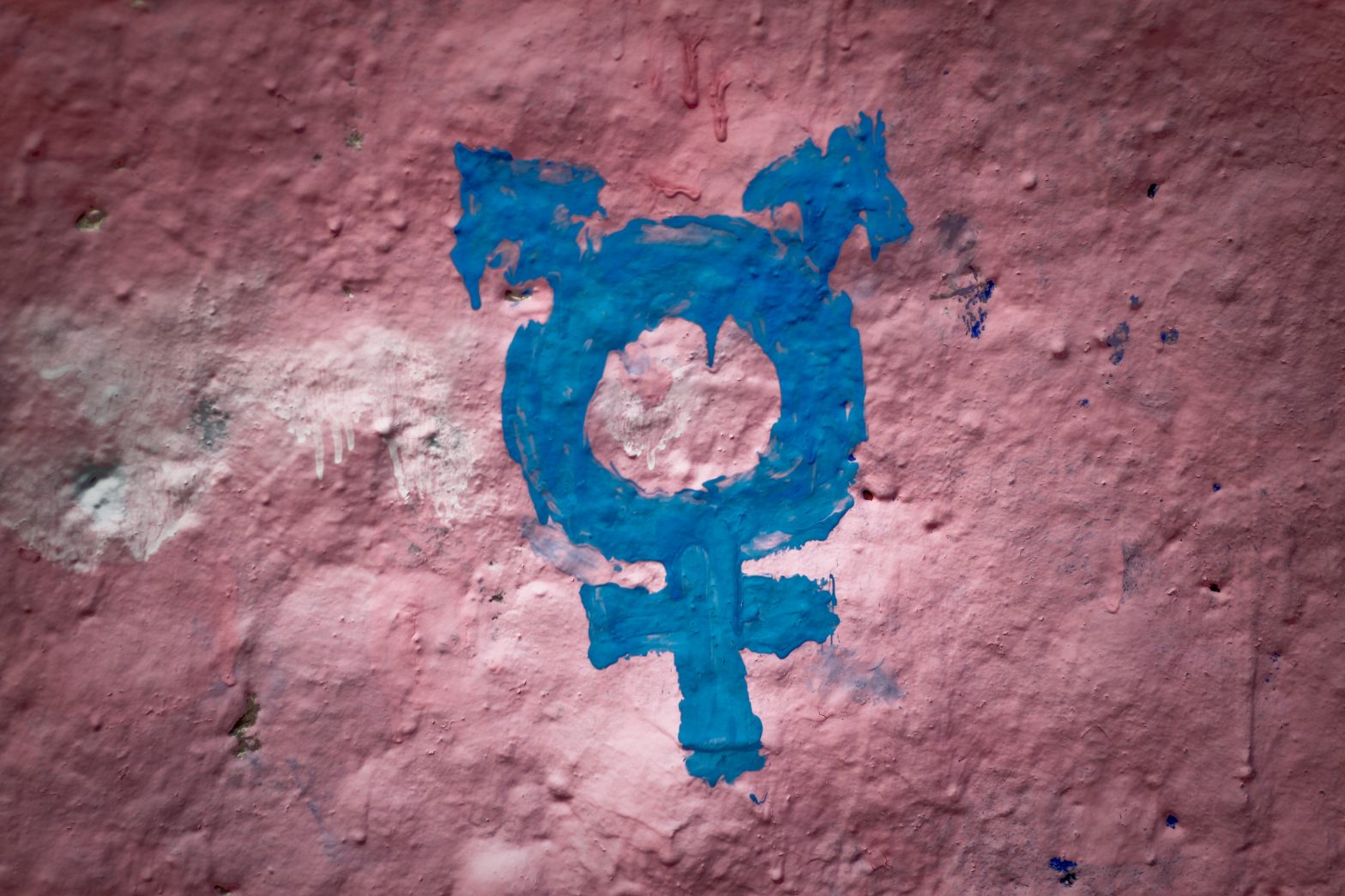A little while ago, I spoke about how professor Jordan Peterson acted as a lightning rod for Canadians to express their opposition with acceptance of trans people. This opposition has reached a point where it is threatening the passage of Bill C-16, also known as the trans rights bill. In this article, I’m going to cover the opposition.
Jordan Peterson
A few months ago, professor Jordan Peterson published an incoherent rant against non-binary people and Bill C-16, invoking the Soviet Union, calling the Ontario Human Rights Commission a “particularly pathological organization”, stating that using gender-neutral pronouns would make him a “mouthpiece of some murderous ideology person’s gender identity definitions.”
In response, trans people attending the University of Toronto where the professor taught spoke out about this vitriol and demanded that trans students at the university be treated with respect. They organized a teach-in.
An immense backlash followed, not against the professor, but against the trans students. Canadians perceived the opposition to Peterson’s assertions as an affront to their freedom of speech. As I documented in that blog entry, major media outlets in Canada indicated their support for the professor, with seemingly only small queer outlets sympathizing with those on the receiving end of his words. As best as I can tell, the only acceptable response that Canadian public would have tolerated was silence on the part of trans people and no demands for the professor to treat them with respect.
Peterson spoke against Bill C-16 in his rant, stating that it would infringe on freedom of speech. The backlash picked up that narrative, making its way through the media and Parliament. What was initially about a transphobic professor and students objecting to his bigotry at one university became much much bigger.
What Bill C-16 Does
As a refresher, Bill C-16 adds “gender identity and gender expression” to the Human Rights Act and to the criminal code. You can see the full text of the bill here.
The modification to the Canadian Human Rights Act, Section 2. This is the section that explains the purpose of the Act:
2 The purpose of this Act is to extend the laws in Canada to give effect, within the purview of matters coming within the legislative authority of Parliament, to the principle that all individuals should have an opportunity equal with other individuals to make for themselves the lives that they are able and wish to have and to have their needs accommodated, consistent with their duties and obligations as members of society, without being hindered in or prevented from doing so by discriminatory practices based on race, national or ethnic origin, colour, religion, age, sex, sexual orientation, gender identity or expression, marital status, family status, disability or conviction for an offence for which a pardon has been granted or in respect of which a record suspension has been ordered.
The modification to the Canadian Human Rights Act, Subsection 3(1). This is the subsection that identifies the eligible grounds for discrimination:
3 (1) For all purposes of this Act, the prohibited grounds of discrimination are race, national or ethnic origin, colour, religion, age, sex, sexual orientation, gender identity or expression, marital status, family status, disability and conviction for an offence for which a pardon has been granted or in respect of which a record suspension has been ordered.
The modification to the Criminal Code, Subsection 318(4). This is in the subsection that makes it illegal to advocate or promote genocide:
(4) In this section, identifiable group means any section of the public distinguished by colour, race, religion, national or ethnic origin, age, sex, sexual orientation, gender identity or expression, or mental or physical disability.
The modification to the Criminal Code, Subparagraph 718.2(a)(i). This is in the section for sentencing after an individual has been found guilty of a crime:
(i) evidence that the offence was motivated by bias, prejudice or hate based on race, national or ethnic origin, language, colour, religion, sex, age, mental or physical disability, sexual orientation, or gender identity or expression, or on any other similar factor,
The Opposition
Bill C-16 is currently in the Senate. The Senate is where the previous incarnation of this bill, Bill C-279, was killed. There is much more opposition now as a result of the lightning rod effect. According to Amnesty International, who have been involved in the effort to advance C-16, “Senators are being flooded with messages opposing” Bill C-16.
Current public exposure to Bill C-16, through Google search results, Twitter, newspapers and the media is being framed through the lens of the opposition. The focus of the opposition is around free speech and the claim that misgendering an individual would now be a hate crime.
Examples of Public Exposure to Bill C-16
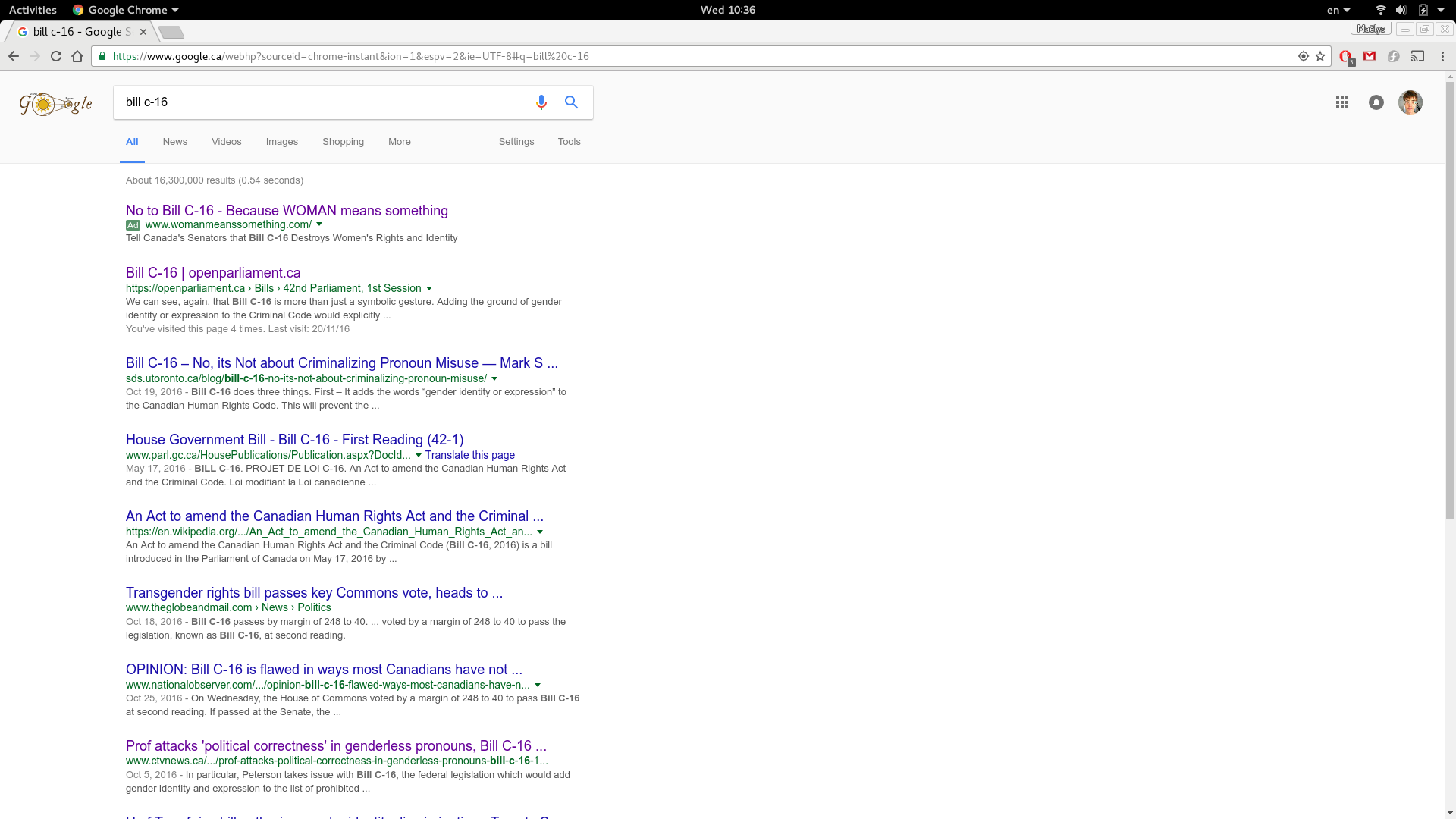
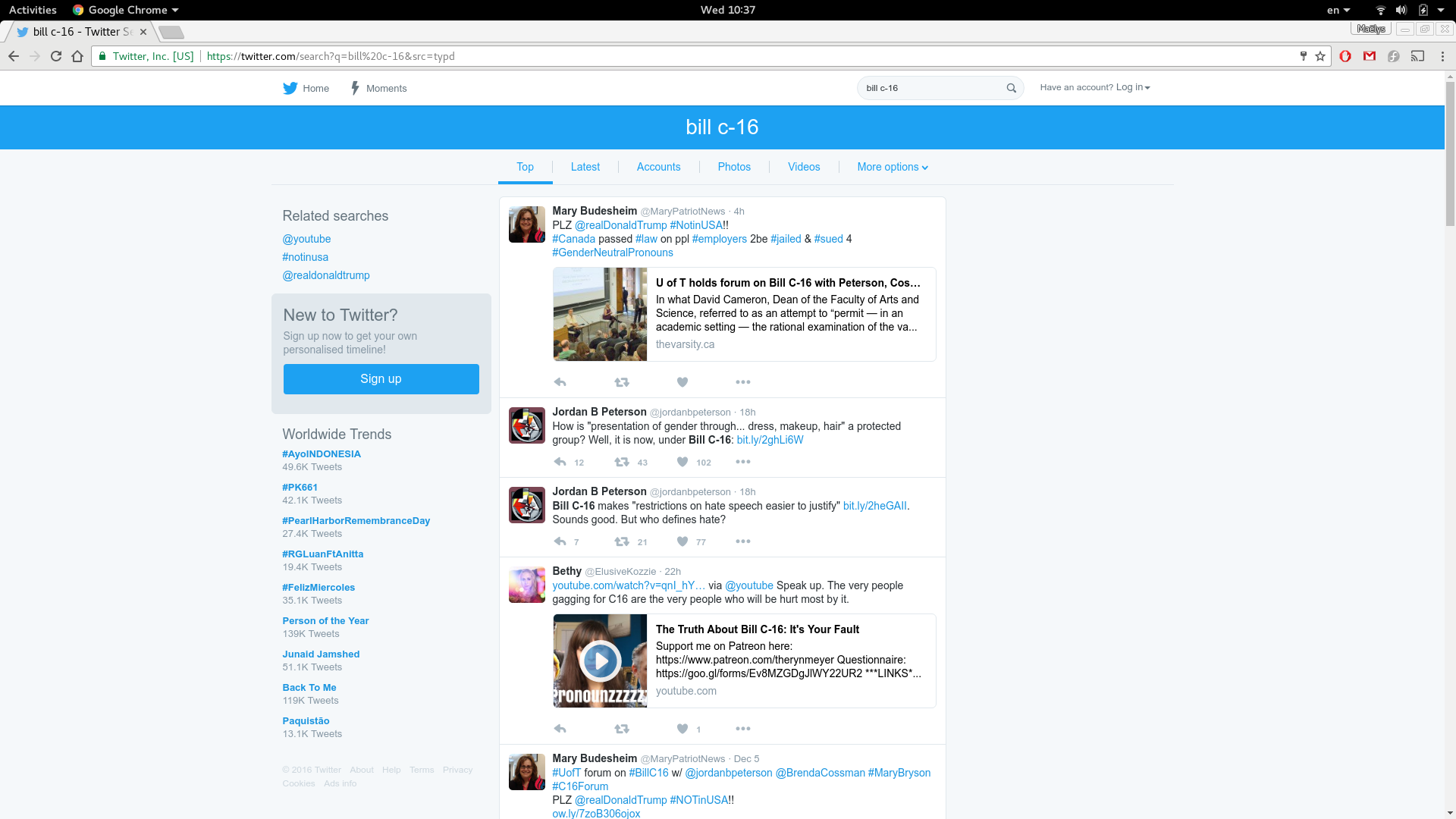
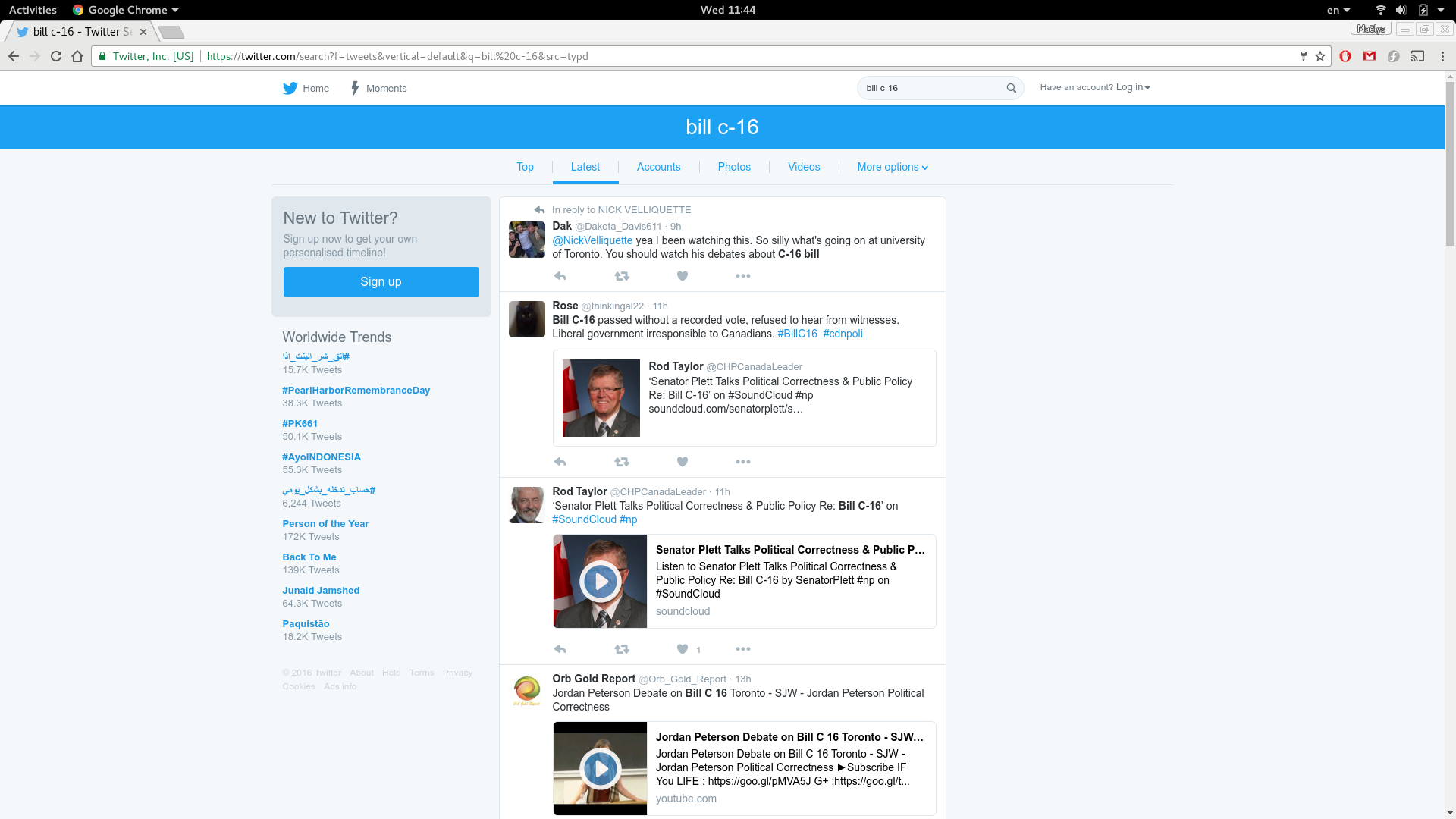
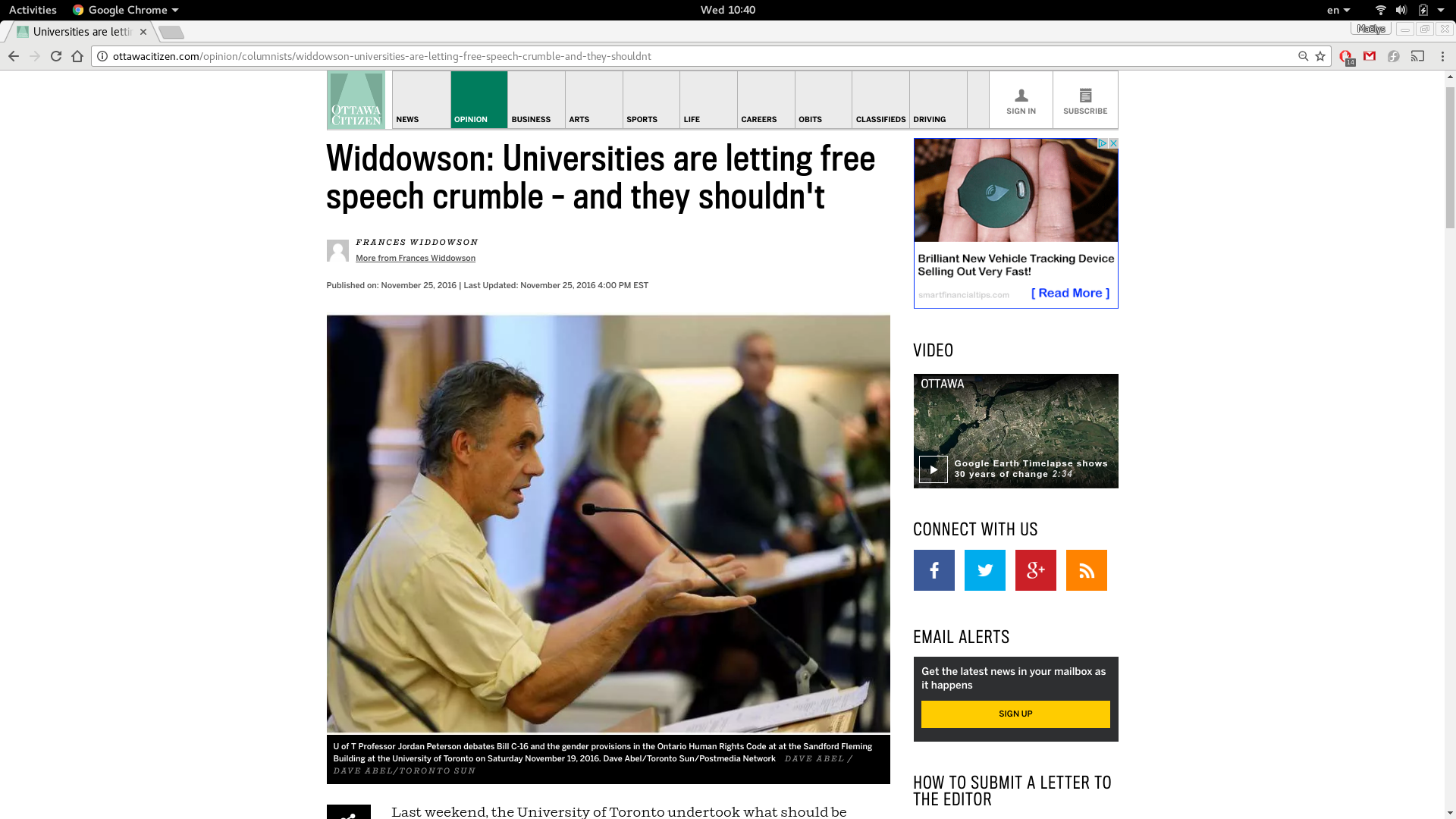
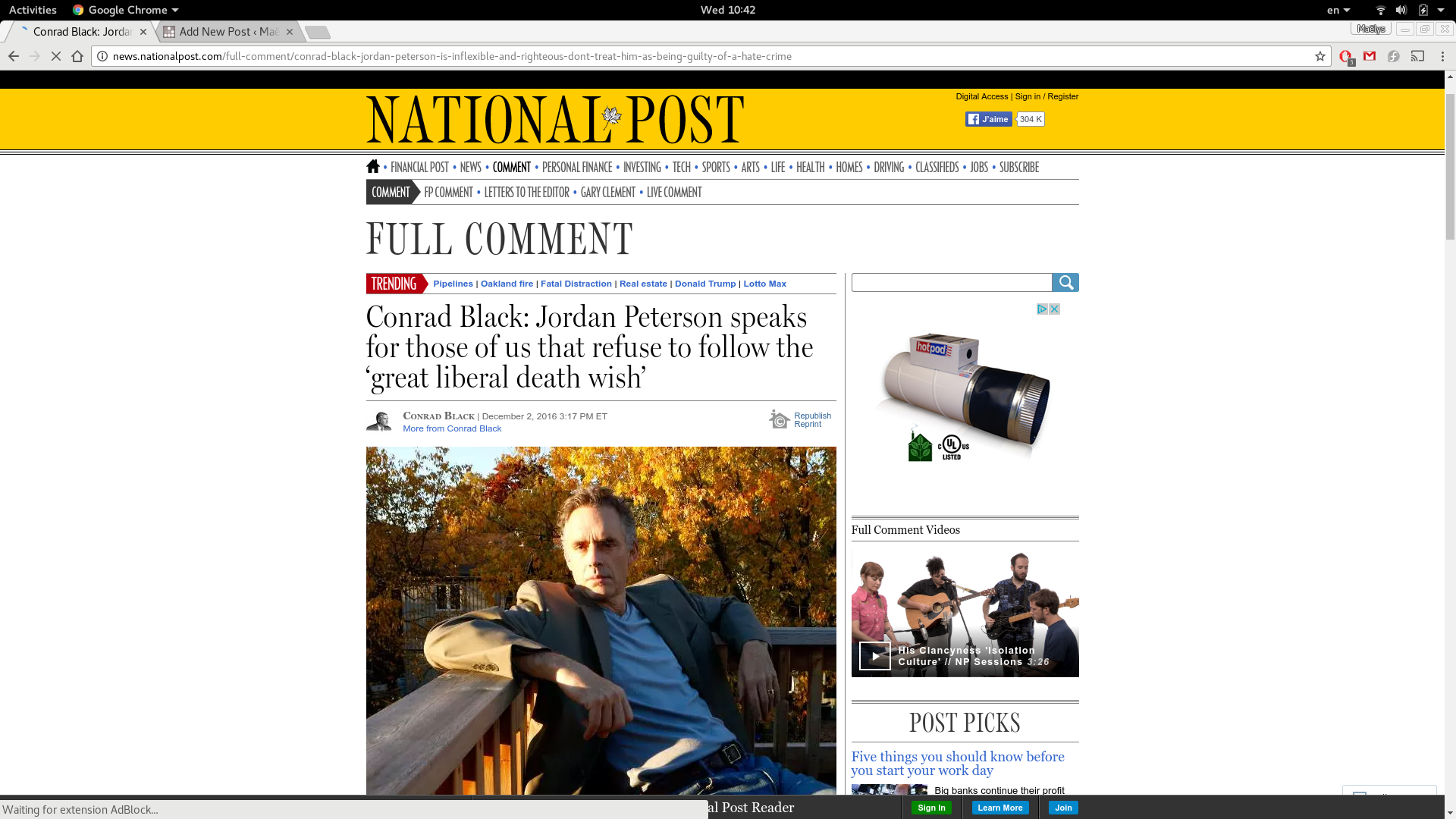
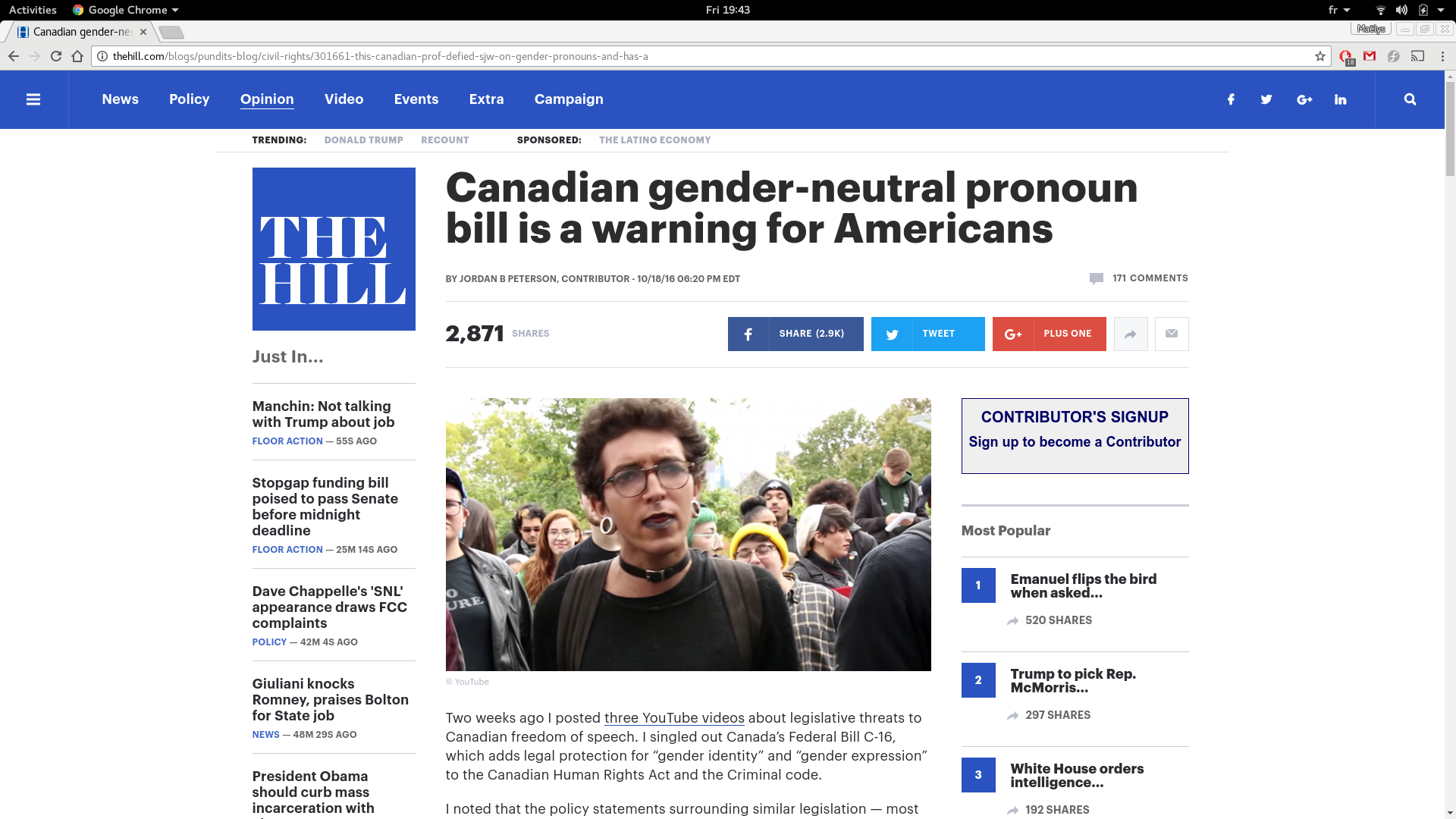
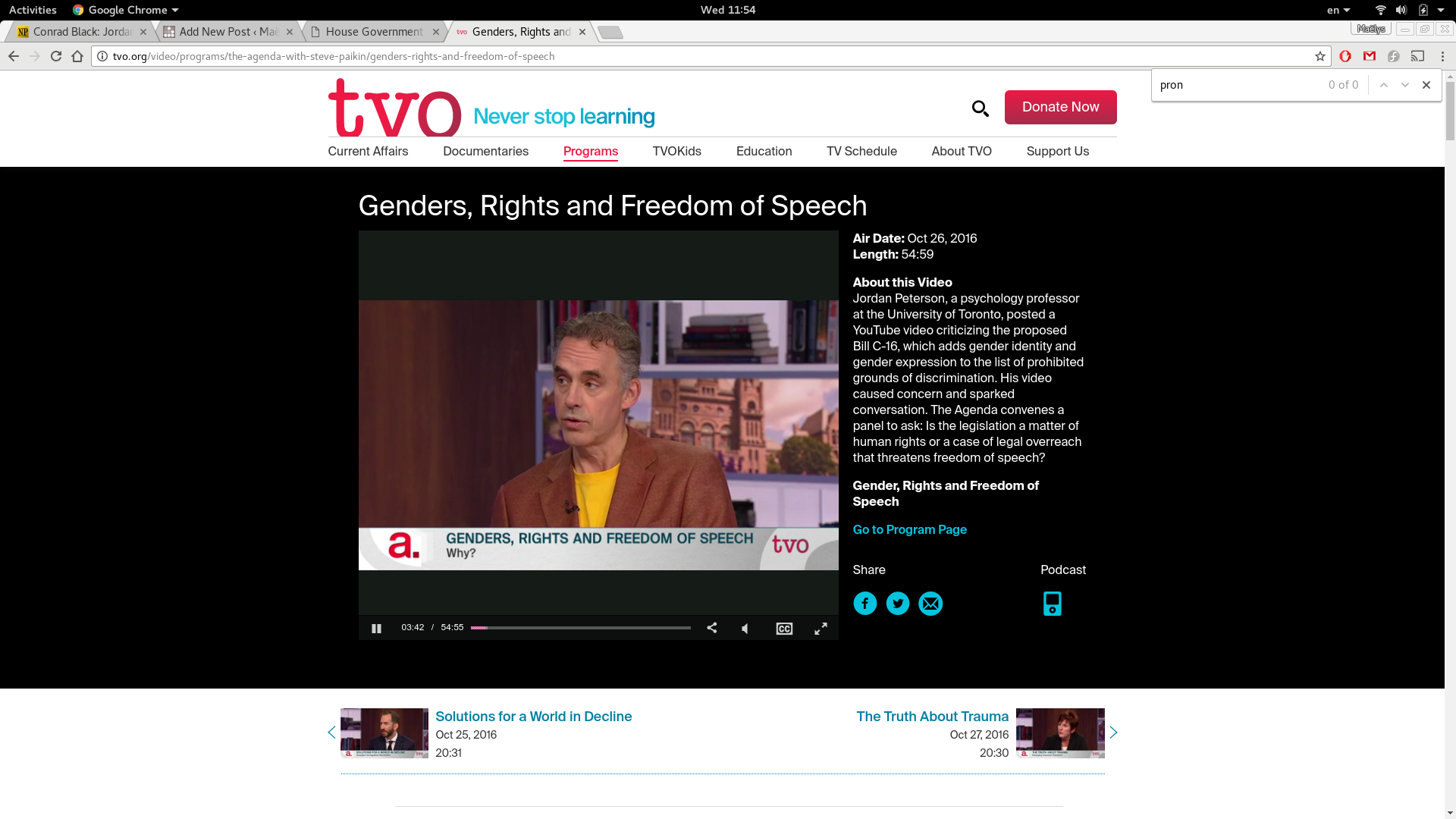
Google Trends Data on Bill C-16
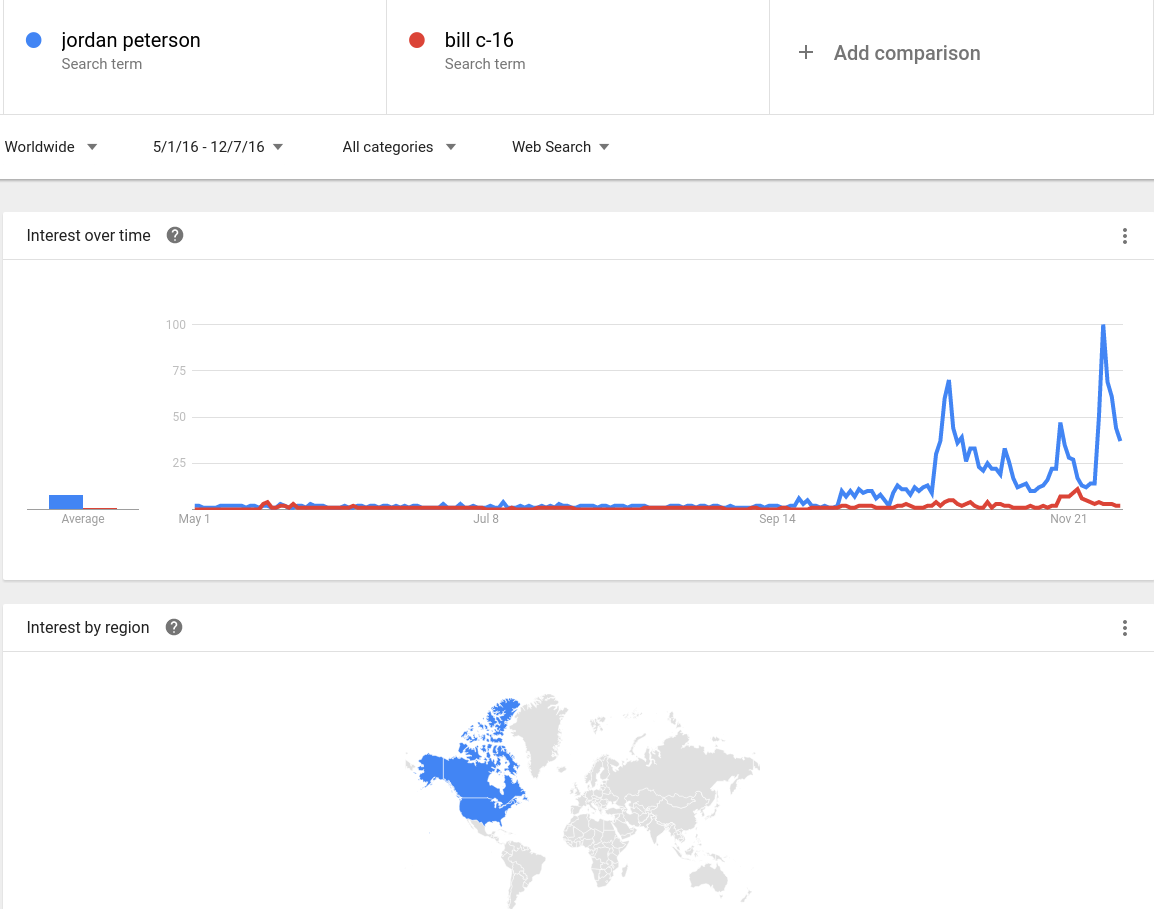
The chart above shows the popularity of particular Google searches over time. Two things to note. First, there’s much more interest in “Jordan Peterson” than there is in “Bill C-16”. Second, that the attention to Bill C-16, in particular it’s much publicized introduction on May 17th, 2016, is insignificant as compared to the attention it got following the Peterson affair. In other words, attention on Bill C-16 is shaped by interest in Jordan Peterson and his negative take on the legislation.
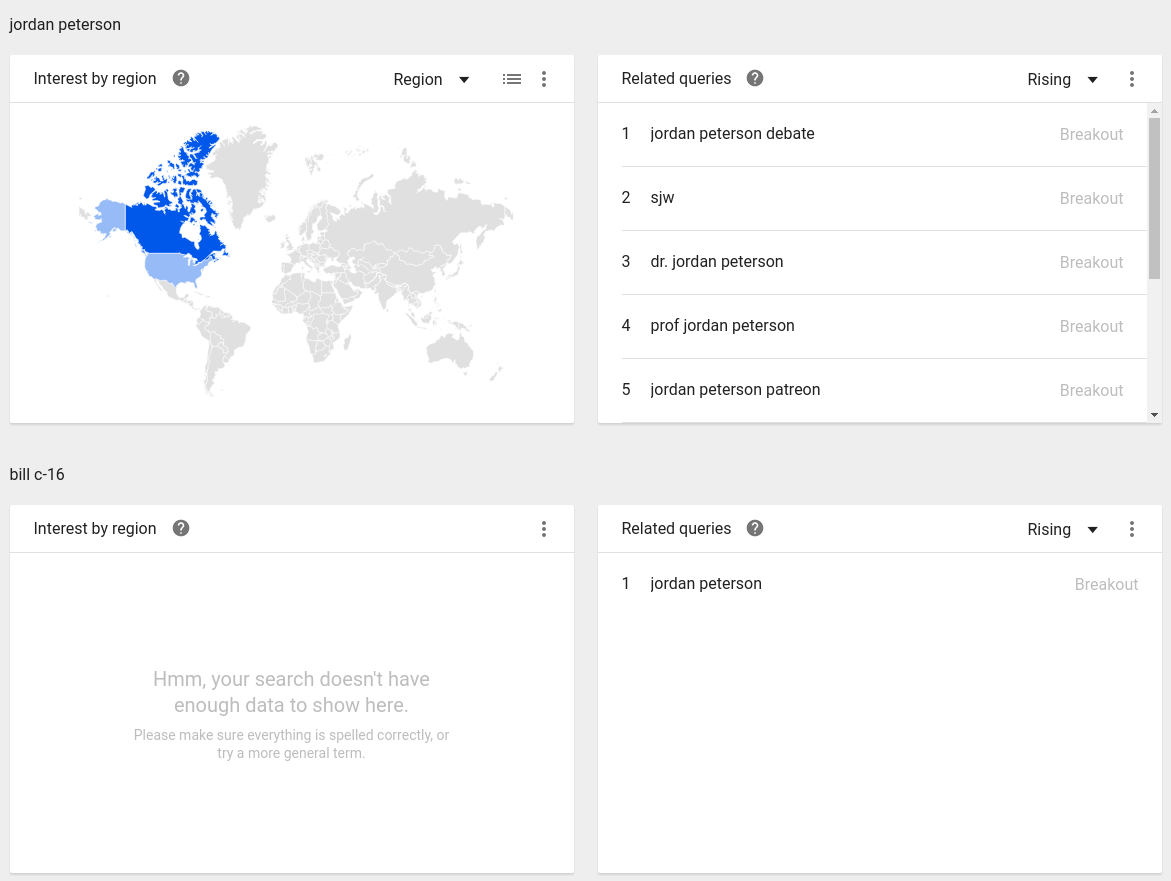
The chart above shows the popularity of Google searches by region, as well as showing related searches. A few things to note. First, there is interest in “Jordan Peterson” coming from the United States. Second, far more people are interested in Jordan Peterson than Bill C-16. Third, when they search for “Bill C-16” it’s in association with an interest in “Jordan Peterson”. Fourth, those with an interest in Jordan Peterson also demonstrate interest in “SJW”, which is an acronym for “social justice warrior”, a pejorative often reserved for individuals advocating for the rights of trans people and other marginalized communities.
Observations about the Opposition to Bill C-16
There’s a few things to note about the opposition.
- Opposition is far exceeding support. The opposition is dominating Google, Twitter, newspaper editorials, and television. It is flooding Senators offices.
- The opposition is almost entirely associated with Jordan Peterson.
- Americans are getting involved in the opposition.
- There is a fundamental misrepresentation of what Bill C-16 does that echoes Peterson’s alarmist and misguided take on the legislation.
- As a result of its dominance in the media and online, the opposition is getting to frame the bill for the public. In doing so, the content and effects of the bill are being misrepresented and reduced to fear mongering around pronouns, much like previous opposition had reduced the discourse around trans rights to fear mongering about washrooms.
- There is little interest by major media outlets in listening to trans people and presenting a more sensible review of the legislation, much less doing so without invoking Jordan Peterson. Non-binary trans people are being regularly lambasted for their pronouns in the media and the suggestion is made that Bill C-16 will restrict freedom of speech.
- Freedom of speech appears to be the main argument made in opposition of the bill. Freedom of speech seems to be the successor to the freedom of religion argument, presenting anti-discrimination legislation as infringing on the rights of perpetrators.
- The opposition would have been unlikely to exist in this amount had the bill proceeded through Parliament before the events surrounding Jordan Peterson. It could also die out in a year, as other lightning rod issues have. This is perhaps the most inopportune time for the bill to make its way through Parliament.
What You Can Do
Contact Senators
Here’s a list of priority Senators, provided by Amnesty International. Contact them. Let them know you support Bill C-16 and oppose the discrimination trans people face.
Opponents are reducing discourse of the bill to fear mongering around freedom of speech and washrooms. Discussions about the discrimination faced by trans people and what the bill actually does is getting sidelined. I’ve provided talking points below to assist in redirecting the discourse back to discrimination and the need for such simple anti-discrimination measures.
Talking Points – Supporting Bill
- Canadians support Bill C-16.
- Trans people represent a significant number of Canadians.
- Trans people face discrimination in Canada.
- Discrimination acts as a barrier to employment, health care, education, travel, and full participation in society.
- 96% of trans Ontarians have heard trans people are not normal.
- 73% of trans Ontarians have been mocked for being trans.
- 20% of trans Ontarians have been physically or sexually assaulted for being trans.
- 34% of trans Ontarians had been verbally threatened or harassed but not assaulted.
- 13% of trans Ontarians have been fired for being trans, and another 15% of trans Ontarians were fired, and believed it might be because they were trans.
- 18% of trans Ontarians were turned down for a job; another 32% suspected this was why they were turned down.
- 17% of trans Ontarians were declined a job they had applied for and were actually offered, because of the lack of a trans-positive and safe work environment.
- 57% of trans Ontarians avoided washrooms over fear of their safety.
- 32% of trans Ontarians had to move away because they were trans, either for their safety or to access services.
- 40% of trans Ontarians had experienced discriminatory behaviour from a family doctor at least once.
- 24% of trans Ontarians reported having been harassed by police.
- Discrimination costs lives.
- 43% of trans Ontarians had a history of attempting suicide, including 10% within the past year.
- The numbers are higher for trans people of colour, trans youth, trans seropositive individuals, trans individuals with lower educational attainment, and trans individuals with lower household income.
- 57% of trans youth 16-24 in Ontario with unsupportive parents attempted suicide in the past year.
- Research published in the Lancet Journal shows that the distress is not as a result of being trans, but as a result of the experiences of social rejection and violence.
Talking Points – Addressing “Freedom of Speech” Narrative
- There is no hate speech provision in the Criminal Code pertaining to pronoun use or where pronoun use would be applicable.
- The Criminal Code changes has to do with advocating for genocide and considering gender identity or expression when someone is being sentenced for a criminal act, for instance, after having been found guilty of assault or murder.
- While not using someone’s pronouns on purpose isn’t legally hate speech, it does create a toxic environment. In the same way that a cisgender purposefully misgendering another cisgender person would be bullying.
- There is no civil process to deal with hate speech in Canada. Police cannot charge anyone with criminal hate speech without the express approval of the provincial attorney general. Even once this approval is obtained, the process is time-consuming and expensive.
- This high bar was partially due to the repeal of Section 13 in 2012.
- Mark Steyn is brought up as an example by opponents of supposed abuse of hate speech legislation. Mark Steyn wrote anti-Muslim articles and had a human rights complaint against him as a result. The case was dismissed, but opponents cite punishment by process (cost, time.) That case occurred previous to the repeal of Section 13.
- Clauses for gender identity and gender expression already exists provincial human rights legislation.
- Clauses for gender identity and gender expression already exist in the human rights legislation of Alberta, British Columbia, Newfoundland & Labrador, Nova Scotia, Ontario and Prince Edward Island.
- Clauses for gender identity already exists in the human rights legislation of Manitoba, Northwest Territories and Saskatchewan.
- The cases that have come before the tribunals have to do with the discrimination that trans people face: being fired for being trans, facing sterilization as a requirement to update a gender marker on documents, etc.
- Any other application of the law, such as to use “gender identity and gender expression” to restrict free speech, is simply not grounded in the reality of how these laws have been applied.
- These clauses already exist in the federal Human Rights Act for other grounds.
- The other grounds are: race, national or ethnic origin, colour, religion, age, sex, sexual orientation, marital status, family status, disability and conviction for an offence for which a pardon has been granted or in respect of which a record suspension has been ordered.
- The tribunal has set a precedence of permissiveness with freedom of speech, including when it decided in favour of Mark Steyn for his outspoken anti-Muslim rhetoric. This would not change.
- The “freedom of speech” argument appears only to be applied to gender identity and gender expression, in the same way that “freedom of religion” was seemingly only applied to sexual orientation. The arguments could be made of every other clause, but they aren’t.
- Freedom of speech is not freedom of consequence.
- Just as a professor spouting an incoherent sexist rant against women at university could face repercussions, so too a professor rallying the same against transgender individuals.
- Trans people have a right to exercise their own freedom of speech and advocate for themselves. This is not a right that is only reserved to cisgender individuals. It is not an infringement of that right for trans people to affirm that they must be treated with respect.
Talking Points – Addressing “Bathroom Predator” Narrative
- Recognizing gender identity does not open the door for male sexual predators to use the women’s washroom.
- Clauses for gender identity and gender expression already exist in the human rights legislation of Alberta, British Columbia, Newfoundland & Labrador, Nova Scotia, Ontario and Prince Edward Island.
- Clauses for gender identity already exists in the human rights legislation of Manitoba, Northwest Territories and Saskatchewan.
- Protections at the provincial level have not been accompanied by a rise in sexual assault.
- These protections already exist in 16 states in the US. As Media Matters found, following the introduction of such protections, there wasn’t a documented rise in sexual assaults.
- The bathroom predator threat is a myth.
- The predator argument is logically inconsistent.
- Sexual assault is illegal. Using the incorrect washroom is not. The idea that predators are waiting for a non-discrimination clause to enter a washroom and commit an illegal act doesn’t hold water.
- Subscription to this myth implies that male predators who are waiting to assault young girls are are already in the men’s washroom with young boys, and the discourse is to keep them in the washroom with boys. Letting trans people use washrooms doesn’t figure in this.
- There are many trans Canadians, and they deserve to use the right washroom.
- Transgender Canadians make up roughly 0.6% of the population, or approximately 210,000 Canadians. 57% of trans Ontarians reported avoiding washrooms over fears of their safety.
- Looking to the US, which largely mirrors Canadian data, 32% of trans people limited the amount they ate or drank to avoid restroom use. 24% had their washroom use questioned/challenged in the past year. 12% had been verbally harassed for using the washroom in the past year. 9% were denied restroom access in the past year. 8% had a kidney or urinary tract infection, or another kidney-related medical issue, because they avoided restrooms.
- Isolated incidents is not reason enough to deny 210,000 Canadians the right to use the correct washroom.
